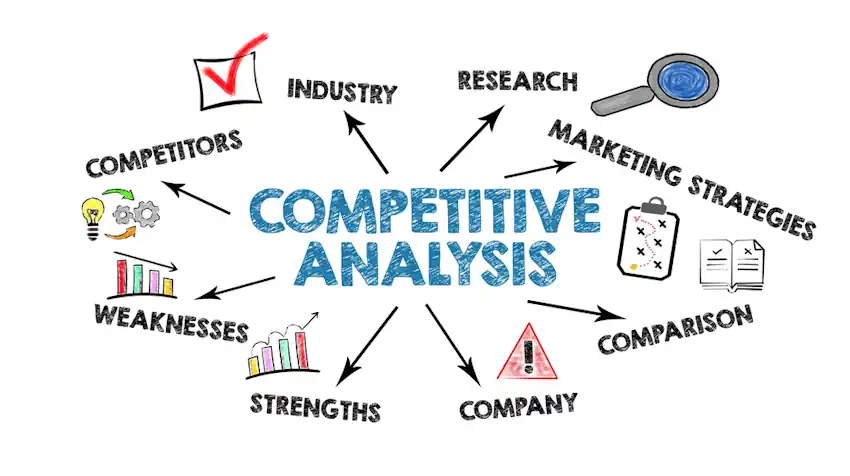In today’s competitive business landscape, understanding your market position and staying ahead of competitors is crucial for success. As a freelance consultant offering competitor analysis services, you can provide valuable insights that help businesses make informed strategic decisions and gain a competitive edge. This guide explores how to establish and grow a successful competitor analysis service, from understanding client needs to delivering actionable recommendations that drive results.
By offering competitor analysis services, you help businesses gain a clear understanding of their market landscape, identify strengths and weaknesses in their competition, and uncover opportunities to gain a competitive advantage.
Many companies struggle with gathering and interpreting competitor data in a way that informs their strategy. Your expertise in conducting detailed competitor research and analysis allows clients to make data-driven decisions, improve their products or services, and position themselves more effectively in the market.
Understanding Client Goals
Your process begins by understanding the client’s specific goals for the competitor analysis. Different businesses have different priorities when it comes to analyzing competition—some may be focused on pricing strategies, others on product features, marketing tactics, or customer experience.
You’ll work closely with the client to clarify what they want to achieve through the analysis, whether it’s identifying gaps in the market, benchmarking their performance, or finding new ways to differentiate their offerings. This step ensures that your research and analysis are aligned with the client’s business objectives and provide actionable insights.
Research and Competitor Identification
Once the goals are defined, you’ll begin the research phase by identifying key competitors. This might include direct competitors offering similar products or services, as well as indirect competitors who cater to the same target audience but with a different solution.
Depending on the client’s industry, you’ll also look at new entrants or emerging competitors that may pose a future threat. By creating a comprehensive list of competitors, you ensure that the analysis covers all relevant players in the market, giving the client a full picture of their competitive environment.
Data Gathering Process
With the list of competitors in hand, you’ll start gathering data across a variety of channels. This might include analyzing competitors’ websites, social media presence, product offerings, pricing models, marketing campaigns, customer reviews, and SEO strategies.
You’ll also look at industry reports, press releases, or public financial statements where applicable. For eCommerce businesses, this might involve analyzing product listings, promotions, or customer ratings on platforms like Amazon. By compiling this data, you provide the client with a detailed view of how their competitors operate and what strategies they are using to engage their audience.
Key Areas of Analysis
Product and Service Comparison
Evaluating the features, benefits, and pricing of the client’s products or services compared to their competitors. You’ll identify where the client’s offerings are stronger or weaker, helping them understand how they stack up in terms of quality, innovation, and value.
Market Positioning
Analyzing how competitors position themselves in the market, including their branding, messaging, and unique selling propositions (USPs). You’ll assess how well competitors communicate their value and how they differentiate themselves, which helps the client refine their own positioning strategy.
Marketing and Advertising Strategies
Examining the types of marketing channels competitors use, such as social media, SEO, email campaigns, or paid advertising. You’ll analyze what messaging resonates with their audience, how they structure their campaigns, and where they allocate their marketing budget.
Customer Experience Analysis
Reviewing customer feedback and reviews on platforms like Google, Yelp, or Trustpilot to gauge how competitors handle customer service, product delivery, and overall satisfaction.
SEO and Online Presence
Analyzing competitors’ search engine rankings, backlink profiles, keyword strategies, and website performance. You’ll look at the competitors’ content marketing efforts, including blogs, videos, and other resources that drive traffic to their website.
Sales and Distribution Channels
Assessing the platforms and methods competitors use to sell and distribute their products or services. This includes understanding whether they use direct sales, eCommerce platforms, third-party retailers, or B2B channels.
Innovation and Trends
Identifying any emerging trends or innovations that competitors are adopting, such as new technologies, business models, or partnerships.

Creating Comprehensive Reports
After gathering and analyzing the data, you’ll compile the findings into a comprehensive competitor analysis report. The report will be structured in a way that’s easy for the client to navigate, with clear sections for each aspect of the analysis, such as product comparisons, market positioning, and marketing strategies.
You’ll use data visualizations like charts, graphs, and tables to present key findings, making the report more engaging and easier to understand. Each section will include insights that directly address the client’s goals, helping them see how they can use the information to their advantage.
Developing Actionable Recommendations
The report will also include actionable recommendations based on the analysis. These recommendations may involve adjusting pricing strategies, improving product features, adopting new marketing tactics, or refining customer service practices.
By offering specific, data-driven suggestions, you provide the client with a roadmap for improving their market position and gaining an edge over their competitors. For example, if the analysis reveals that a competitor excels in social media engagement, you might recommend that the client increase their presence on specific platforms or run targeted campaigns to boost their visibility.
Ongoing Monitoring Services
Ongoing competitor monitoring can also be offered as part of your service. Competitor landscapes are constantly evolving, and staying up to date with new developments, marketing campaigns, or product launches can give the client a continuous edge. Offering regular updates or quarterly reports ensures that the client remains aware of any changes in the competitive landscape and can adjust their strategies accordingly.
Pricing Strategies
Pricing your competitor analysis services can vary depending on the depth of the analysis, the number of competitors reviewed, and the specific areas of focus. Some clients may need a quick, high-level analysis for a product launch, while others may require a more comprehensive, ongoing competitor tracking service.
Offering tiered pricing based on the scope of the project allows you to cater to different types of businesses, from startups to larger enterprises looking for detailed market insights.
Marketing Your Services
Marketing your competitor analysis services requires demonstrating your ability to deliver actionable insights that help businesses grow. Sharing examples of past competitor analysis reports, along with testimonials from satisfied clients, helps build credibility and showcase your expertise.
You can promote your services through freelance platforms, LinkedIn, or your own website, and by networking with entrepreneurs, product managers, and marketing professionals who can benefit from a deeper understanding of their competitive landscape.
Is This Business Right for You?
A competitor analysis business could be an excellent fit if you:
- Have a knack for research and enjoy diving deep into data to uncover meaningful patterns and insights
- Excel at analyzing complex information and breaking it down into clear, actionable recommendations
- Are naturally curious about business strategies and enjoy staying up-to-date with market trends
- Have strong analytical skills and attention to detail
- Enjoy creating detailed reports and presenting information in a visually appealing way
- Are comfortable working with various digital tools and platforms for research and analysis
- Have good project management skills and can handle multiple analyses simultaneously
- Possess strong communication skills to effectively present findings to clients
- Have experience in marketing, business strategy, or market research (though not required to start)
Getting Started with Competitor Analysis Services
Here are the essential first steps to launch your competitor analysis business:
- Build your analysis toolkit by familiarizing yourself with key research tools like SEMrush, Ahrefs, or Similar Web for digital analysis, and resources like D&B Hoovers or IBISWorld for broader market research
- Create templates for different types of competitor analyses, including frameworks for evaluating products, pricing, marketing strategies, and market positioning
- Develop a systematic process for gathering and organizing competitive intelligence that you can replicate across different industries
- Put together a sample competitor analysis report using publicly available information about well-known companies in a familiar industry to use as a portfolio piece
- Choose a specific niche or industry to focus on initially, which will help you build expertise and create more targeted marketing materials
- Create a simple website showcasing your methodology and the types of insights clients can expect (you can include anonymous excerpts from your sample report)
- Build a network on LinkedIn and other professional platforms by sharing insights about competitive analysis and market trends
- Consider offering a scaled-down analysis at a discounted rate for your first few clients to build case studies and testimonials
Your Path to Success in Competitor Analysis
Offering competitor analysis services is a highly valuable and flexible freelance opportunity. You help businesses understand their competitors, uncover opportunities, and identify areas where they can improve, giving them the insights they need to succeed in their market.
By managing every aspect of the analysis—from research and data collection to providing detailed reports and actionable recommendations—you provide clients with the tools they need to make strategic decisions and outpace their competition. This makes competitor analysis a profitable and scalable freelance business that serves a wide range of industries and clients.




